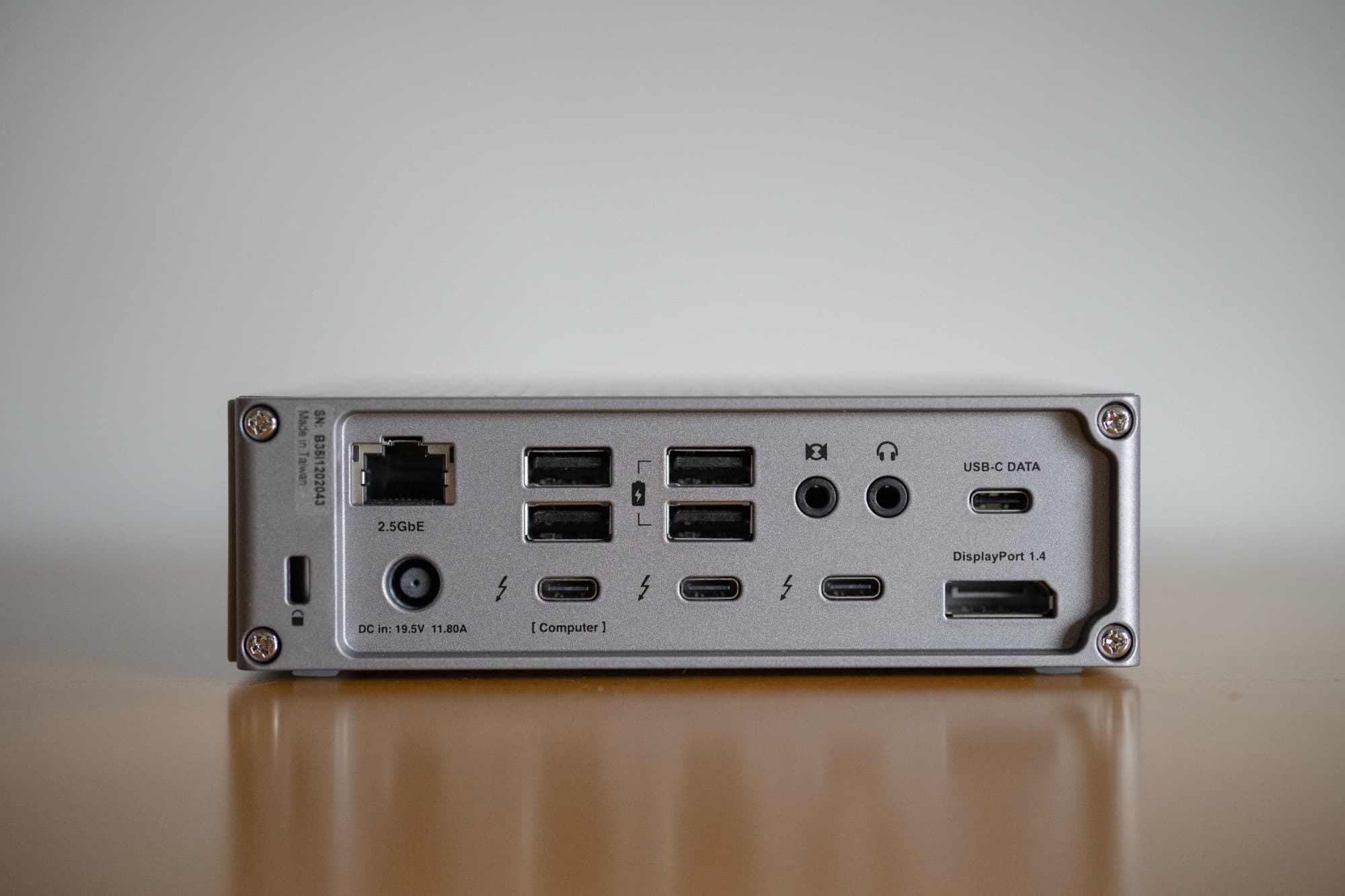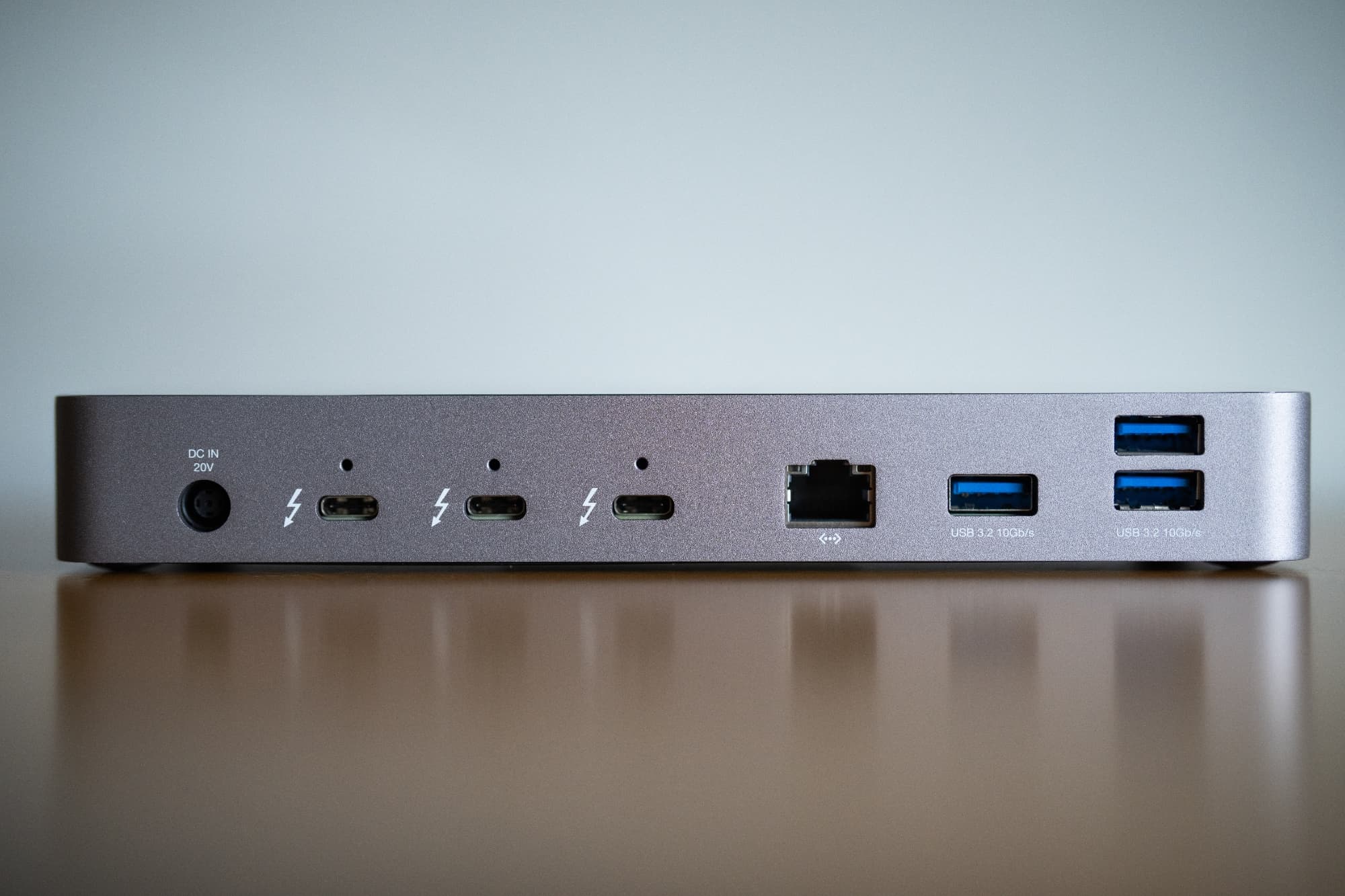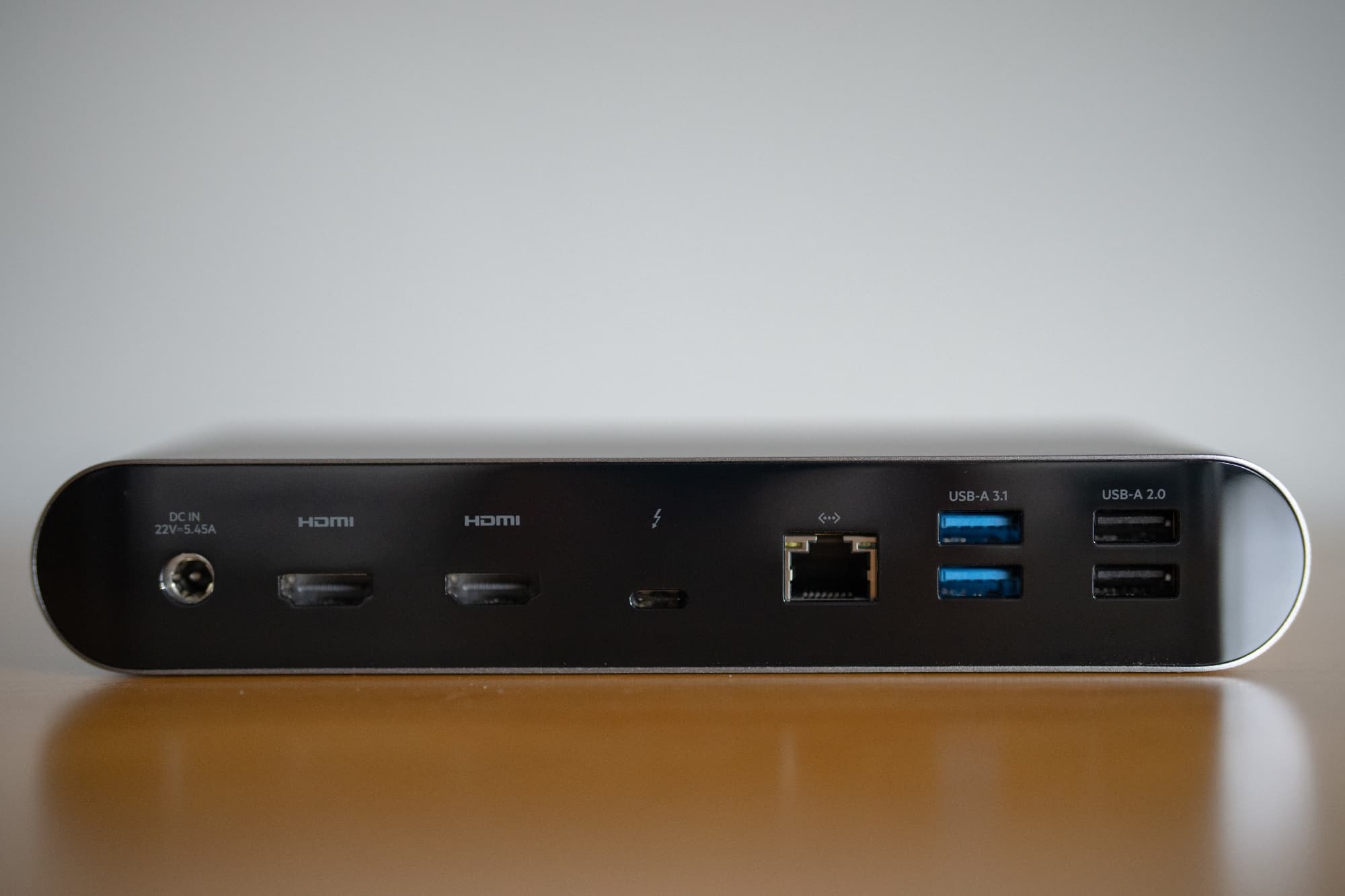Whether you’re a professional pumping out productivity on multiple displays with various types of storage media attached, or you’re an average Joe just trying to have the neatest desk space arrangement that you can, chances are that you could make use of a Thunderbolt 4 Dock to both maximize connectivity to your Mac or PC and minimize the number dongles and adapters you’d otherwise need to connect to your computer’s ports.
As someone who utilizes multiple displays, constantly connects external solid state drives and camera flash memory cards, and requires a way to keep my MacBook Pro full charged while doing all of those things all at the same time, a Thunderbolt 4 Dock has always been a necessity of mine. I utilize them for both work and play because of the convenience they add to my workspace.
There is absolutely no shortage of Thunderbolt 4 Docks available on the market today, and there are pros and cons to each of them. With that in mind, I’ve personally tested four Thunderbolt 4 Docks while attempting to enhance my workspace, and I’d like to share some of my thoughts on those options for anyone who might be looking to get their feet wet with some Thunderbolt 4 connectivity for the first time.
What to look for in a Thunderbolt 4 Dock
There are several Thunderbolt 4 Dock manufacturers out there, with each one building a product intended to suit a niche purpose. Some Thunderbolt 4 Docks focus much of their I/O on display support, while others provide more connectivity for external drives and storage media. We’ve also discovered well-rounded all-in-one options.
If you’re thinking about purchasing a Thunderbolt 4 Dock for your workspace, then you should begin by asking yourself what you intend to use it for. If your primary purpose is to run a multi-display setup, then you should search for a Thunderbolt 4 Dock that offers lots of display-oriented ports. These might include:
- Additional Thunderbolt ports
- Additional DisplayPort ports
- Additional HDMI ports
- Additional USB-C ports
If you’re instead looking for a way to connect all your external storage peripherals because you’re a professional or amateur photographer or videographer, then you may require more storage-oriented ports. These might include:
- Additional USB-A ports
- Additional USB-C ports
- Additional SD Card slots
- Additional microSD Card slots
- Additional CFExpress Card slots
- Built-in SSD capabilities
If you’re planning to use a Thunderbolt 4 Dock for gaming, streaming, or some other kind of fun activity, then you might be planning to connect external displays, microphones, speakers, and expect the best internet performance that you can get. In this case, you might require a wide variety of ports, including:
- Additional USB-A ports
- Additional HDMI, DisplayPort, USB-C, or Thunderbolt 4 ports
- Dedicated 3.5mm headphone and microphone ports
- An optical audio port
- A dedicated Ethernet port
- And more…
As you can see, different use cases call for different port requirements. You’ll need to factor in the different types of plugs your equipment uses and consider the types of activities you’ll do most to ensure that you get the most out of your Thunderbolt 4 Dock. After all, these things aren’t cheap, so you don’t want to buy the wrong one.
My favorite Thunderbolt 4 Docks
Now that we’ve covered the different needs that individual Thunderbolt 4 Dock users may require, I’m going to walk you through some of my favorite choices based on how I use my computer. With a little help, this roundup will help you choose the correct one for your needs.
CalDigit TS4
CalDigit’s TS4 Thunderbolt 4 Dock offers one hell of a bang for your buck with a jaw-dropping 18 individual ports and a compact form factor that tucks away on any desk. This option can be stood up straight or laid on its side to maximize desk space or to keep a small footprint.
I’ve long appreciated CalDigit’s form factor when it comes to Thunderbolt docking stations, and their latest model doesn’t disappoint. Complete with a space gray color-matched aesthetic, this powerful brick measures just under 6 inches on its longest plane, supports up to 8K displays, and powers any connected laptop with juicy 98W Power Delivery.
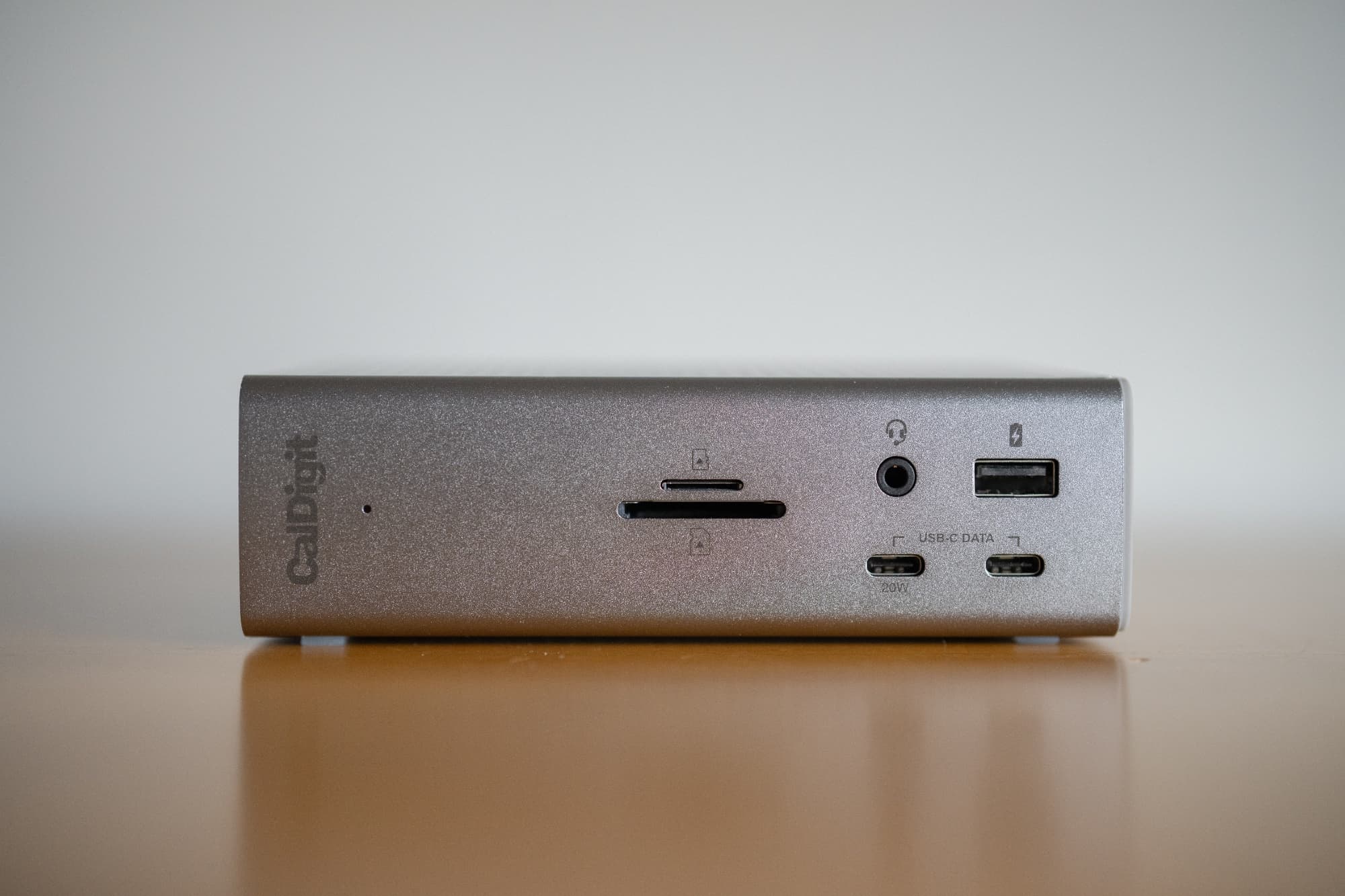
On the front of the CalDigit TS4 Dock, you’ll find the following ports:
- SD 4.0 UHS-II Card Slot
- microSD 4.0 UHS-II Card Slot
- 5mm Audio combo jack
- USB-A 3.2 Gen 2 (10 Gb/s speed and 1.5A 7.5W power)
- USB-C 3.2 Gen 2 (10 Gb/s speed and 5V/3A, 9V/2.22A 20W power)
- USB-C 3.2 Gen 2 (10 Gb/s speed and 1.5A 7.5W power)
On the rear of the CalDigit TS4 Dock, you’ll find the following ports:
- 5GbE Gigabit Ethernet
- 4x USB-A 3.2 Gen 2 (10 Gb/s speed and 1.5A 7.5W power)
- 5mm Audio in
- 5mm Audio out
- USB-C 3.2 Gen 2 (10 Gb/s speed and 1.5A 7.5W power)
- DisplayPort 1.4
- 2x Thunderbolt 4/USB-C 4 Downstream 15W power
- 1x Thunderbolt 4/USB-C 4 Host 98W power
- DC in
- Kensington Lock security slot
You can use the CalDigit TS4 with Thunderbolt 3 or 4-enabled Windows PCs, Intel Macs, Apple silicon Macs, USB-C-enabled Windows PCs and tablets, Thunderbolt or USB-C-enabled iPads, and Thunderbolt or USB-C-enabled Chromebooks. Obviously, you won’t be taking advantage of Thunderbolt 4 when connecting to a USB-C port on your computer or tablet, and there may even be some software constraints, but that’s still superb compatibility.
The CalDigit TS4 might be the single most pro-focused Thunderbolt 4 Dock on this list, simply because it provides so many different data (with power) ports to connect all your peripherals, in addition to two downstream Thunderbolt 4 ports that can run dual external displays. And let’s not forget that the 98W of Power Delivery keeps your laptop fully charged while you use it at its maximum potential.
Because of the sheer amount of I/O packed into the CalDigit TS4, it doubles as a docking station that suits virtually anyone, even gamers and content creators, or someone who just wants a few displays and peripherals being controlled by a single port on the side of their Thunderbolt 4-enabled machine.
While the CalDigit TS4 can serve anyone, whether you’re a professional or just a casual user, it also comes with a mighty $450 price tag.
OWC 11-Port Thunderbolt 4 Dock
We also want to give a shout out to Other World Computing for their 11-port Thunderbolt 4 Dock because it provides astonishingly good connective flexibility, and at a fraction of the price of the CalDigit TS4.
OWC’s Thunderbolt 4 Dock takes a more traditional size and shape as compared to the compact CalDigit TS4, and it’s also worth noting that it sports one extra Thunderbolt 4 port than the CalDigit TS4 does. While its 11 ports may not sound as robust at the 18 found in the CalDigit, the OWC Thunderbolt 4 Dock has it where it counts and lends a respectable 96W of Power Delivery to keep your laptop powered throughout the day.
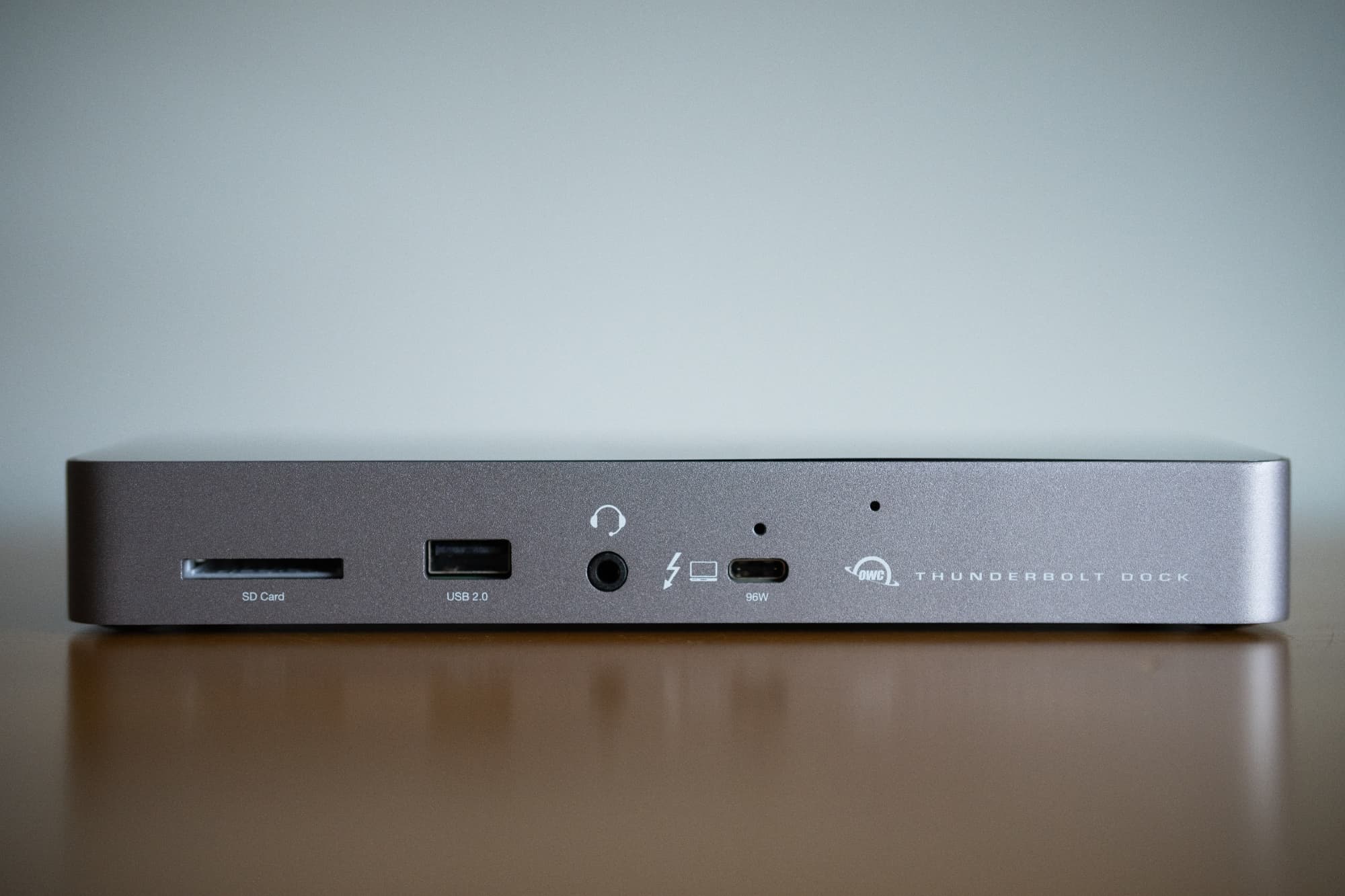
On the front of the OWC Thunderbolt 4 Dock, you’ll find the following ports:
- SD UHS-II Card slot
- USB-A 2.0 port with power
- 5mm Audio combo jack
- Thunderbolt 4/USB-C 4 Host 96W power, OWC ClingOn stabilizer compatible
On the rear of the OWC Thunderbolt 4 Dock, you’ll find the following ports:
- 3x Thunderbolt 4/USB-C 4 Downstream 15W power, OWC ClingOn stabilizer compatible
- Gigabit Ethernet port
- 3x USB-A Gen 2 (10 Gb/s speed and 1.5A 7.5W power)
- DC in
On the side of the OWC Thunderbolt 4 Dock, you’ll find the following:
- Kensington Lock security slot
- Kensington Nano security slot
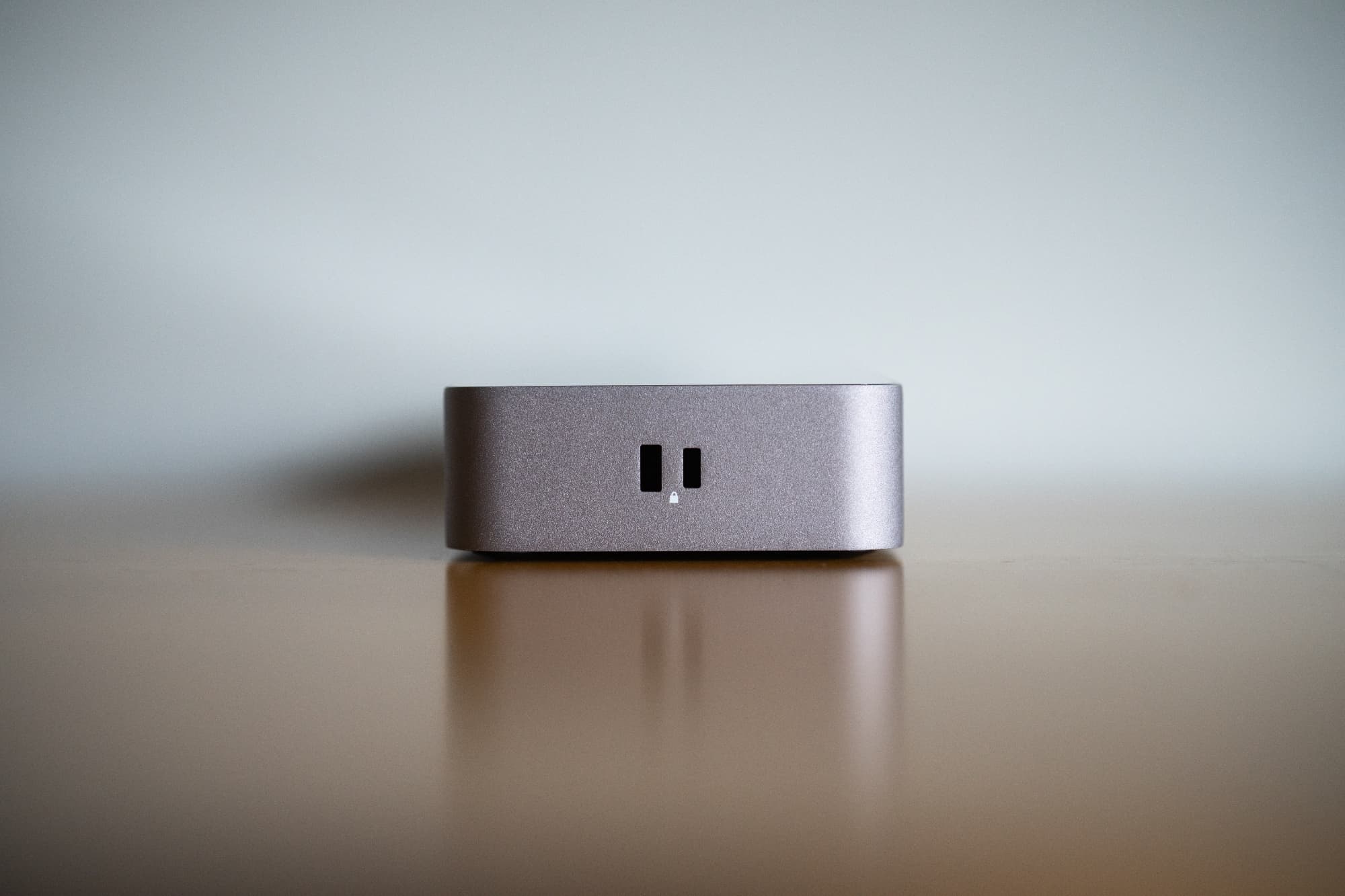
OWC’s 11-port Thunderbolt 4 Dock has all the important connectors that you need for a professional workflow, including an Ethernet connection, connections for multiple Thunderbolt displays, hookups for your audio equipment, slots for memory cards, and USB ports for all your peripherals. It’s well-rounded, and we think well worth your consideration.
Most professionals will excel just fine with the OWC 11-port Thunderbolt 4 Dock, and the price is very attractive at just $250.
Belkin Connect Pro Thunderbolt 4 Dock
Another brand that makes a fantastic Thunderbolt 4 Dock is Belkin, which takes a slightly different approach to your desk space than the options discussed above, primarily in its choice of ports.
The Belkin Connect Pro Thunderbolt 4 Dock boasts 12 ports in total and delivers a sleek aesthetic that looks like it belongs on a desk with Thunderbolt 4-enabled Apple computers. Boasting 90W of power delivery for your laptop, this dock supports high-resolution displays of up to 8K resolution at 30Hz for one display or 4K resolution at 60Hz for dual displays. It even touts being TAA-compliant for use in government applications.
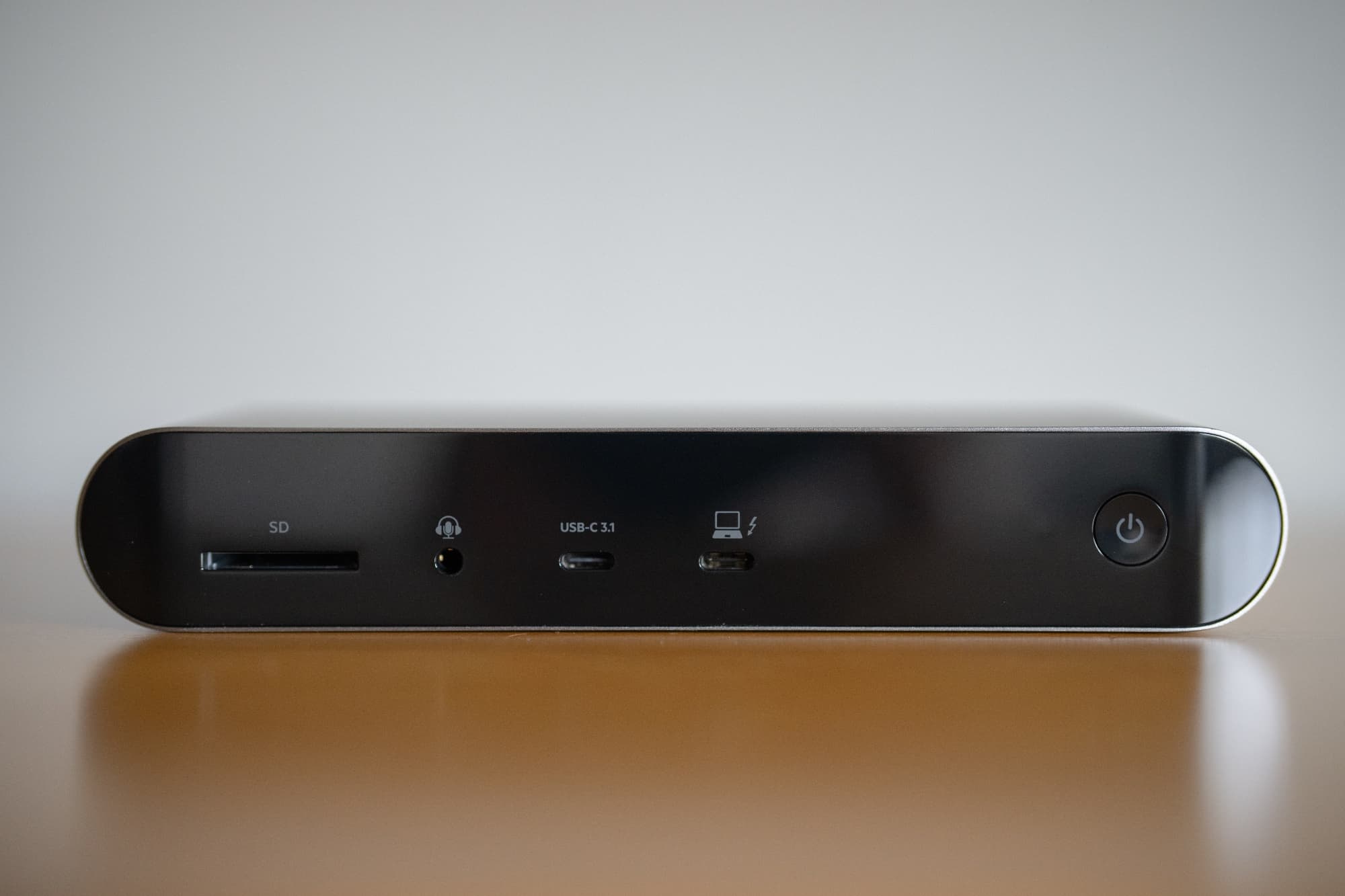
On the front of the Belkin Connect Pro Thunderbolt 4 Dock, you’ll find the following:
- SD UHS-II Card slot
- 5mm Audio combo jack
- USB-C 3.1 Gen 2 (Power Delivery 3.0)
- Thunderbolt 4/USB-C 4 Host 90W power
On the rear of the Belkin Connect Pro Thunderbolt 4 Dock, you’ll find the following:
- 2x HDMI 2.0 ports
- Gigabit Ethernet port
- 2x USB-A 3.1 Gen 2 ports
- 2x USB-A 2.0 ports
- Thunderbolt 4/USB-C 4 Downstream
- DC in
You get a little bit less USB prowess in this dock than you do in the CalDigit or OWC options, but one way it stands out is with its HDMI support, which will be appealing for anyone who uses HDMI-based displays rather than DisplayPort or Thunderbolt-based displays. I’m also a fan of the power button on the front.
The connectivity you see on the Belkin Thunderbolt 4 Dock is more consumer-centric and because many higher-end displays are utilizing either Thunderbolt 4 connectivity. With that in mind, there’s no end to the number of HDMI-based gaming monitors on the market, which means I can see this being ah helpful addition to a multi-displayed gamer.
Of course, the USB, storage card slots, audio ports, and high-speed wired internet ports also provide ample connectivity for streamers or everyday end users who need more ports to connect their USB or camera storage peripherals or headphones/microphones.
We think the Belkin Connect Pro Thunderbolt 4 Dock is going to be a popular choice given the brand’s close work with Apple and the flexible connectivity at the price point offered. You can pick one up for yourself for around $280.
Satechi Thunderbolt 4 Multimedia Dock
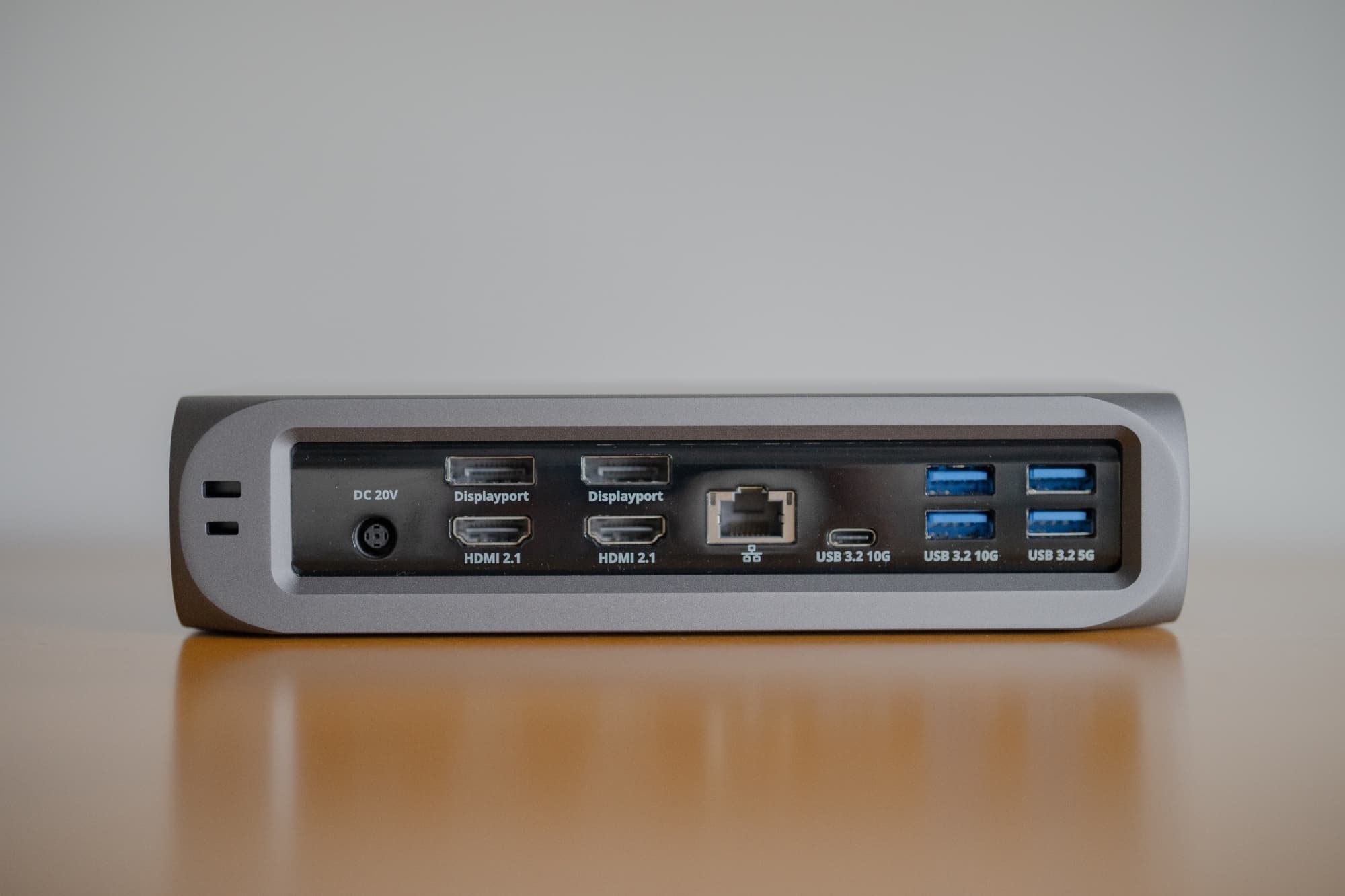
Last, but certainly not least on this list of our recommended Thunderbolt 4 docking stations would have to be Satechi’s Thunderbolt 4 Multimedia Dock.
This impressive and compact option provides the sleek aesthetics that we’ve come to expect from the Satechi brand and mates it with versatile 16-port connectivity that almost anyone would find useful at their desk in a pinch. In fact, we’d even feel comfortable saying that this dock is suitable for both professionals and casual users alike.
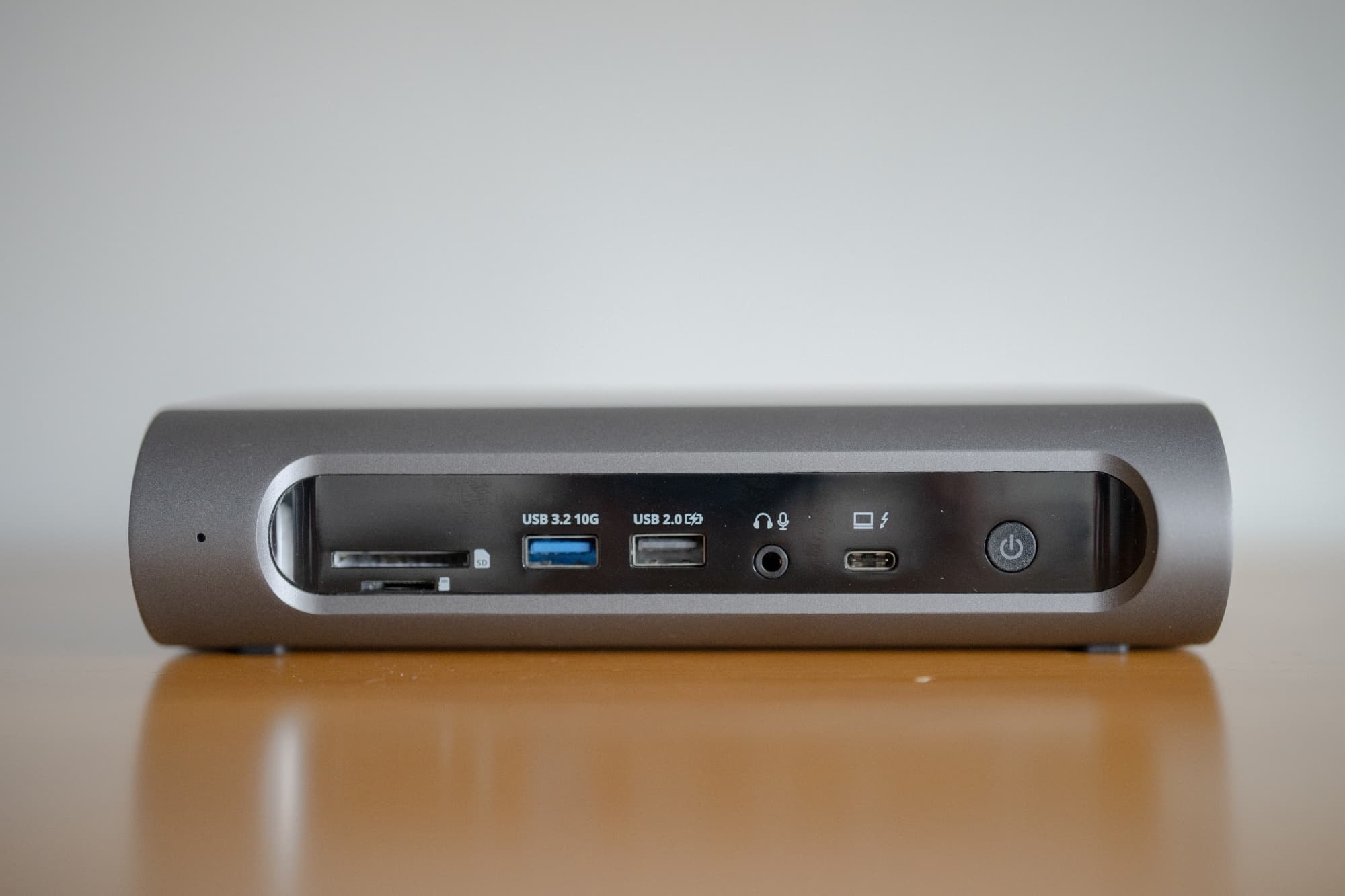
On the front of the Satechi Thunderbolt 4 Multimedia Dock, you’ll find the following:
- SD UHS-II Card Slot
- microSD UHS-II Card Slot
- 5mm Audio combo jack
- USB-A 3.2 Gen 2 (10 Gb/s speed)
- USB-A 2.0 port with power
- Thunderbolt 4/USB-C 4 Host 96W power
On the rear of the Satechi Thunderbolt 4 Multimedia Dock, you’ll find the following:
- 2x USB-A 3.2 Gen 2 (10 Gb/s speed)
- 2x USB-A 3.2 Gen 2 (5 Gb/s speed)
- USB-C 3.2 Gen 2 (10 Gb/s speed)
- 5GbE Gigabit Ethernet
- 2x HDMI 2.1 ports
- 2x DisplayPort ports
- Kensington Lock slot
- DC in
With the Flexibility to connect either HDMI, DisplayPort, or Thunderbolt 4 displays, this option will work with almost any setup you can throw at it. If your computer supports it, then this dock can run up to four external displays at 4K resolution at 60Hz. Two of the USB-A ports can even be used to charge your devices if you need power in a pinch.
We think that the expansive USB connections are perfect for heavy peripheral users, whether you’re connecting hard drives, flash drives, controllers, headphones, microphones, or the likes. The ultra-fast Ethernet also ensures that you’re getting the best possible performance out of your internet connection.
Much like the Belkin Dock, we also appreciate that the Satechi option has a power button, but this dock also borrows from the CalDigit design in that it can be placed horizontally on your desk, or vertically with the included weighted stand.
Satechi’s Thunderbolt 4 Multimedia Dock is a great option for creative professionals and multi-display users alike and can be had for around $350.
Selecting the Best Dock for You
Every Thunderbolt 4 Dock manufacturer is making something that they believe consumers want to have in their workflow. In many cases, the final product differs greatly, with some Thunderbolt 4 Docks being more suitable for creative professionals, and others being more consumer friendly.
Obviously, the goal is route as much of your cables and connections through a single Thunderbolt 4 port on your computer as possible, thereby eliminating the clutter of wires and peripherals that would ordinarily run across your desk and necessitate unsightly dongles everywhere.
When choosing the right one for you, it’s important to consider not only what you have on your desk right now, but also anything you plan to add in the future so that you have all the ports you need. You should consider the number of displays you plan to use, the types of specialized equipment, your power delivery requirements, and whether you plan to run a wired internet connection.
Note that while some Thunderbolt 4 Docks offer plenty of USB-A ports, many of those might be USB 2.0 instead of faster USB 3.1 and faster ports. This may be fine if you plan to use those ports for charging things but may not be ideal for large file transfers. Fortunately, most manufactures are including at least a couple high-speed ports for this purpose, even if they do include some slower USB 2.0 ports.
Size isn’t typically a consideration when it comes to Thunderbolt 4 Dock selection, but aesthetics might be. Try to find an option that not only functions to your standards but meshes well with the appearance of your setup.
My pick
While almost any of the Thunderbolt 4 Docks mentioned above will suit my needs, my personal favorite to have on hand is the CalDigit TS4. That’s because it’s so incredibly compact, yet able to deliver the highest number of useful ports while still powering my MacBook Pro.
Although it’s the most expensive option on this list, I wouldn’t feel bad using the OWC Thunderbolt 4 Dock either. As my second favorite, it provides a satisfactory number of expandable Thunderbolt 4 ports and power delivery in a sleek package, and I also like how it has my computer’s charging port on the front. It’s conveniently also one of the best-priced options.
In terms of aesthetics, I really have to give it to Belkin. The Belkin Thunderbolt 4 Dock looks the most at home on a Mac user’s desk, but that’s not too surprising given Belkin’s often deep partnerships with Apple when it comes to developing accessories for Apple device users. What I think hurts Belkin, however, is that the Dock only supports HDMI ports and not DisplayPort, which lots of professionals still use.
Conclusion
There are tons of Thunderbolt 4 Docks on the market, and certainly more than we’ve shown you today. The ones shown in today’s list are some of our top picks that we tried while attempting to find the best option for our desk space.
The CalDigit TS4 Thunderbolt 4 Dock certainly stands out in terms of the sheer number of ports and its compact size and shape, but that’s something you’re going to pay a premium for. Almost any of those featured above would have suited our needs, and there are some fantastic bargains available from other brands if the CalDigit TS4 is out of your budget range.
What Thunderbolt 4 Dock stands out the most to you and why? Be sure to let us know in the comments section down below.
